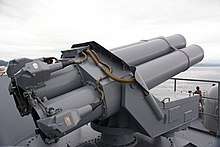F120
|
The Cologne
|
||||||||||||||||
|
||||||||||||||||
|
||||||||||||||||
|
||||||||||||||||
|
||||||||||||||||
F120 is the internal marine name of a former frigate class of the German Navy , also named after its type ship Cologne class . The ships were put into service between 1961 and 1964. Together with the destroyers of the Hamburg class they were the first new construction for the German navy. Developed at the HC Stülcken Sohn shipyard in Hamburg, they represented a world premiere with the new CODAG drive .
Escort duties, mainly anti-submarine hunts, were provided as tasks . The ships were initially designated as " Escort Boat 55" and assigned to the 2nd Escort Squadron in Cuxhaven. On April 3, 1968, the 2nd escort squadron was moved from Cuxhaven to Wilhelmshaven . The Emden and Karlsruhe withdrew from the squadron and temporarily joined the fleet service squadron in Flensburg , from which the Karlsruhe returned to the 2nd escort squadron on October 1, 1973, and the Emden on April 1, 1974.
Class 120 frigates were decommissioned between 1982 and 1989. The Augsburg was scrapped, the Cologne in Operational Training Center Marine prevent damage in Neustadt as Übungshulk recycled, the frigates Emden , Karlsruhe , Lübeck and Braunschweig were to the Turkish Navy issued.
construction
The class 120 frigates were built as smooth- deckers and had very elegant lines. The very diagonally cut bow and the knuckle ribs in the foredeck ensured good sailing characteristics. The hull and parts of the superstructure were made of shipbuilding steel, other superstructure parts were made of aluminum. Due to the installation of gas turbines, large side air inlets were necessary, which could be closed by louvers. The stern was designed as a round stern. The large chimney was sloped and skirted. Behind the bridge superstructure stood the tall lattice mast with radar and other antennas. The hull was divided into 13 watertight compartments.
drive
A CODAG (Combined Diesel And Gas) drive was used for the first time in the Cologne class . This system consisted of four 16-cylinder V- diesel engines from MAN , each with 3,000 horsepower for cruising and two BBC - gas turbines , each with 12,000 hp for top speed, which could be interconnected via planetary gear and their strength on two controllable pitch propellers transferred.
Two electrical plants with three MWM TRHs 5/18 / V16 diesel generators each with 550 PS (405 kW) were available for the power supply. In normal operation, two to three generators were sufficient; To start up the two gas turbines, which were actually designed for power plants on land, all six diesel generators had to be switched on. The main engines were in department five, the electrical works in departments six and eight, and the two gas turbines in department seven. Each turbine used 63 m³ air / sec and approximately 3.5 tons of diesel / h. Action radius at 18 knots (kn): 5,200 nautical miles (nm), 23 kn: 3,500 nm and at full speed (30 kn): 950 nm.
Armament
On the forecastle was a 10 cm gun, behind it, higher up, a 4 cm twin gun . Behind it were two quadruple anti-submarine rocket launchers 37.5 cm from Bofors. A 4 cm Bofors single gun on each side of the aft superstructure and another 4 cm double mount at the end of the superstructure. There was a second 10 cm gun on the quarterdeck. There were also two 53.3 cm torpedo tubes behind the front superstructures. With them were Mk-44 - torpedoes fired. Mine rails were laid behind the torpedo tubes and ran to the stern.
Units, squadrons and locations
All six Cologne- class units (F120) were part of the 2nd escort squadron in Cuxhaven and Wilhelmshaven during their service , with the two frigates Emden (F221) (April 1968 to April 1974) and Karlsruhe (F223) (April 1968 to September 1973) ) were temporarily subordinate to the fleet service squadron in Flensburg .
| Identifier | Surname | Call sign until Nov. 30, 1981 / from Dec. 1, 1981 |
Keel laying | Shipyard | Launch | Commissioning | Decommissioning |
|---|---|---|---|---|---|---|---|
| F220 | Cologne | DBRV / DRAK | December 21, 1957 | HC Stülcken son | December 6, 1958 | April 15, 1961 | 17th December 1982 |
| F221 | Emden | DBRW / DRAL | April 15, 1958 | HC Stülcken son | March 21, 1959 | October 24, 1961 | June 30, 1983 |
| F222 | augsburg | DBSF / DRAM | October 29, 1958 | HC Stülcken son | 15th August 1959 | April 7, 1962 | March 30, 1988 |
| F223 | Karlsruhe | DBSG / DRAN | December 15, 1958 | HC Stülcken son | October 24, 1959 | December 15, 1962 | March 28, 1983 |
| F224 | Lübeck | DBSI / DRAO | October 28, 1959 | HC Stülcken son | July 23, 1960 | June 6, 1963 | December 1, 1988 |
| F225 | Braunschweig | DBSJ / DRAP | July 28, 1960 | HC Stülcken son | 3rd February 1962 | June 16, 1964 | 4th July 1989 |
literature
- Siegfried Breyer, Gerhard Koop: The ships, vehicles and planes of the German Navy 1956 until today. Munich 1996, ISBN 3-7637-5950-6 .
Web links
Remarks
- ↑ The original planning term was "Escort Type 55"

